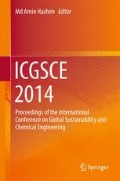Abstract
The increasing demand in wood fibre consumptions especially in pulp and paper making has pushed forward the search for alternative fibre resources. Non-woods derived fibre could be good candidates due to its abundance availability. The objective of this study is to determine the potential of non-wood plants as alternative fibres for pulp and paper-based industries based on its chemical and physical properties. The chemical properties involved in this study (cellulose, hemicellulose, lignin, hot water and 1 % NaOH solubilities and ash contents) were determined according to relevant TAPPI test, Kurscher-Hoffner and Chlorite methods. Meanwhile, the physical properties (fibre length and diameter) were determined according to the Franklin method. In order to propose the suitability of the studied non-wood plants as alternative fibre resources in pulp and paper-based industries, the obtained results are compared to properties of published wood resources. Results show that lignin content (5.67 %) and 1 % NaOH solubility (19.64 %) of cogon grass are the lowest compared to cocoa pod husk and oil palm leaf. These contents influenced the production of higher pulp yield. Although cogon grass contains short fibres length than oil palm leaf, the paper product will have higher strength due to the good inter-fibre bonding. This study conclude, based on the chemical and physical properties, the cogon grass, cocoa pod husk, and oil palm leaf are suitable to be used as alternative fibre resources in pulp and paper-based industries with various applications such papers, boxes and craft materials.
Access this chapter
Tax calculation will be finalised at checkout
Purchases are for personal use only
References
Reddy N, Yang Y (2005) Biofibers from agricultural byproducts for industrial applications. Trends Biotechnol 23(1):22–27
Abdul Khalil HPS, Siti Alwani M, Mohd Omar AK (2006) Chemical composition, anatomy, lignin distribution and cell wall structure of Malaysian plants waste fibers. BioResource 1(2):220–232
Jabatan Perangkaan Malaysia, JPM (2011) Perangkaan Ekonomi Malaysia, Siri Masa Retrieved on 08 May 2012. www.statistics.gov.my
Cruz G, Pirilä M, Huuhtanen M, Carrión L, Alvarenga LE, Keiski RL (2012) Production of activated carbon from cocoa (Theobroma cacao) pod husk. J Civil Environ Eng 2(2):1–6
Malaysia Palm Oil Board Statistics, MPOB (2011). Retrieved 10 Nov 2011. http://www.mpob.gov.my
Shuit SH, Tan KT, Lee KT, Kamaruddin AH (2009) Oil palm biomass as a sustainable energy source: a Malaysia case study. Energy 34(9):1225–1235
WanRosli WD, Law KN (2011) Oil palm fibers as papermaking material: potentials and challenges. BioResources 6(1):901–917
Coile NC, Shilling DG (1993) Cogongrass, Imperata cylindrical (L.) Beauc: a good grass gone bad! Botany Circular 28:1–3
Agele SO, Agbona AI (2008) Effects of cocoa pod husk amendment on soil and leaf chemical composition and growth of cashew (Anacardium occidentale L).seeding in the nursery. Am-Euraasian J Sustain Agric 2(3):219–224
Shakhes J, Marandi MAB, Zeinaly F, Saraian A, Saghafi T (2011) Tobacco residuals as promising lignocellulosic materials for pulp and paper industry. Bioresources 6(4):4481–4493
Jacobs RS, Pan WL, Fuller WS, Mckean WT (1999) Genetic and environmental influences on the chemical composition of Washington state wheat straw. In: 1999 pulping conference proceedings of Atlanta, TAPPI Press. pp 839–847
Wathén R (2006) Studies on fiber strength and its effect on paper properties. Ph.D. Thesis, Helsinki University of Technology
Al-Mefarrej HA, Abdel-Aal MA, Nasser RA (2013) Chemical evaluation of some lignocellulosic residues for pulp and paper production. Am-Eurasia J Agric Environ Sci 13(4):498–504
Marques, Rencoret J, Ana G, José CDR (2010) Evaluation of the chemical composition of different non-woody plants fibers used for pulp and paper manufacturing. Open Agric J 4:93–101
Tran AV (2006) Chemical analysis and pulping study of pineapple crown leaves. Ind Crops Prod 24:66–74
Ai J, Tschirner U (2010) Fiber length and pulping characteristics of switchgrass, alfalfa stems, hybrid poplar and willow biomasses. Bioresour Technol 101(1):215–221
Saijonkari-Pahkal K (2001) Non-wood plants as raw material for pulp and paper. Master’s Thesis, University of Helsinki
Akpakpan AE, Akpabio UD, Ogunsile BO, Eduok UM (2011) Influence of cooking variables on the soda and soda-ethanol pulping of Nypa Fruticans petioles. Aust J Basic Appl Sci 5(12):1202–1208
Chandra M (1998) Use of nonwood plant fibres for pulp and paper industry in Asia: potential in China. Master’s Thesis, State University
Heriksson G, Elisabet B, Helena L (2009) The trees. In: Monica Ek, Göran G, Heriksson Gunnar (eds) Wood chemistry and wood biotechnology vol 1. Walter de Gruyter GmBH and Co, United State of America, pp 13–44
Acknowledgment
This research was financially supported by the Fundamental Research Grant Scheme (FRGS) and scholarship from Universiti Tun Hussein Onn Malaysia (UTHM). The authors are thankful for this financial support.
Author information
Authors and Affiliations
Corresponding author
Editor information
Editors and Affiliations
Rights and permissions
Copyright information
© 2015 Springer Science+Business Media Singapore
About this paper
Cite this paper
Kassim, A., Aripin, A., Hatta, Z., Daud, Z. (2015). Exploring Non-wood Plants as Alternative Pulps: From the Physical and Chemical Perspectives. In: Hashim, M. (eds) ICGSCE 2014. Springer, Singapore. https://doi.org/10.1007/978-981-287-505-1_3
Download citation
DOI: https://doi.org/10.1007/978-981-287-505-1_3
Published:
Publisher Name: Springer, Singapore
Print ISBN: 978-981-287-504-4
Online ISBN: 978-981-287-505-1
eBook Packages: Chemistry and Materials ScienceChemistry and Material Science (R0)

